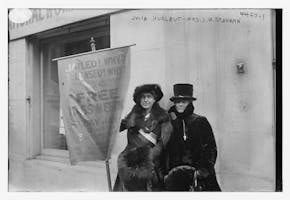A Stage for Women’s Suffrage
“It is built to stand for ages, and during these ages it is probable that this hall will intertwine itself with the history of our country. All good causes may find here a platform.” —Andrew Carnegie
By the time Carnegie Hall opened in 1891, women’s suffrage had established itself as a major movement within the broader fight for women’s rights in the United States. For more than 40 years, the women’s suffrage movement worked toward achieving the legal right for women to vote before it was passed in 1920 as part of the 19th Amendment.
At a time when women were denied political, professional, and educational rights, Carnegie Hall served as a space where they could come to experience collective empowerment. In the early 20th century, there were more than two dozen events hosted at the Hall solely devoted to the topic of women’s suffrage, ranging from mass meetings and conventions to lectures and rallies. At each event, women turned out in droves. From doctors to lawyers, social workers to musicians, New York City women proved their determination to work together to improve their own lives. Of course, this primarily represents the well-known history of white women’s activism and not the totality of the suffrage movement that involved sustained activism from women of color—especially African American women—who faced additional barriers and fought for equitable voting access for all individuals.
For more than 125 years, Carnegie Hall’s history has been intertwined with the history of our country. From its very beginnings, Andrew Carnegie intended for the hall to be a “people’s house,” where music could be presented alongside lectures, rallies, and organizational meetings. These non-musical events have given voice to the issues of our time, providing a space for civic discussion, learning, and collective support.
Photography: Notice of Woman Suffrage Mass Meeting courtesy of the Library of Congress, Rare Book and Special Collections Division, NAWSA Miller Scrapbook Collection; suffragettes picketing courtesy of the Library of Congress, George Grantham Bain Collection; all other images courtesy of the Carnegie Hall Rose Archives.
Explore More
Noted civil rights leaders—such as Martin Luther King Jr., W. E. B. Du Bois, Booker T. Washington, and Marcus Garvey—have all spoken at Carnegie Hall.



